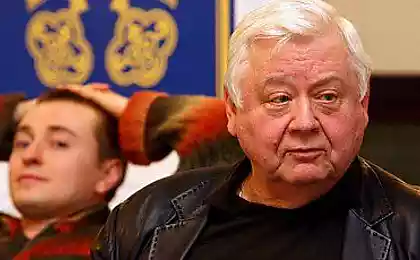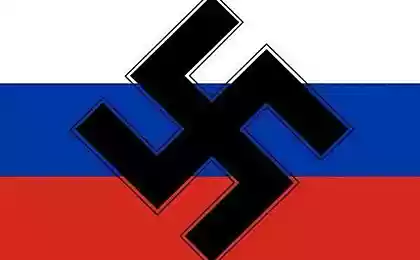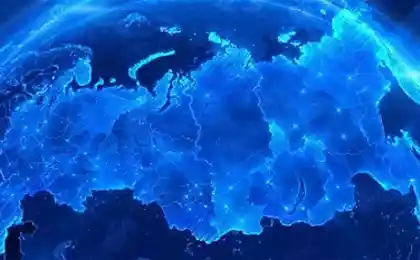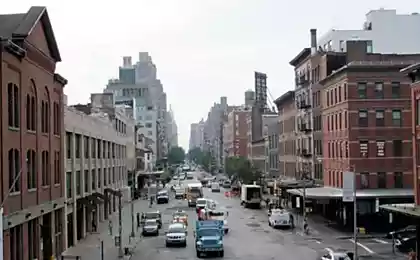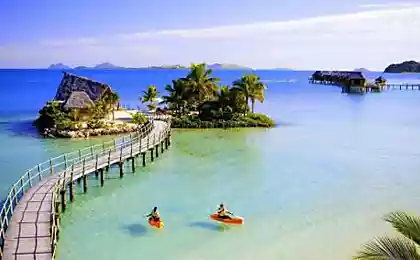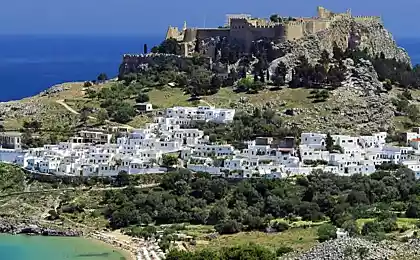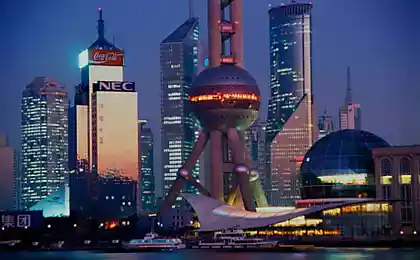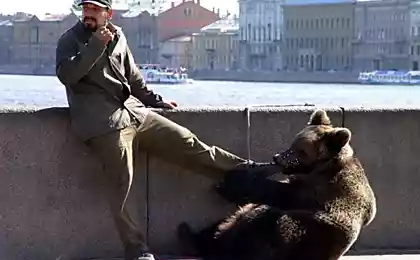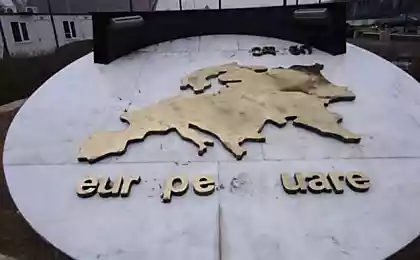1308
Russia Attractions
Ten of the most important attractions of the country, who were chosen by a vote in the contest, "Russia 10»
Lake Baikal
Lake Baikal is the largest repository of high-quality fresh water. Lake Baikal is concentrated approximately 1/5 of the world's fresh water reserves and 9/10 Russia. The volume of water in it is greater than all the combined Great Lakes of North America, and 25 times greater than in Lake Ladoga. The length of the lake extends for 636 kilometers in width - at 80. Baikal area is 31,470 square kilometers, which is comparable to the area of Belgium. Lake Baikal - the deepest lake in the world. Its maximum depth is 1642 meters. The average depth of the lake is also great - 744 meters. Flora and fauna endemic Baikal by two-thirds. More than 1,000 species of plants and animals not found in any body of water of the Earth. Baikal seal - the seal - the only representative of mammals in the lake. Baikal - one of the oldest lakes in the world. It has been around for 25 million years, and possibly a nascent ocean. Its shores are drifting apart from each other, just as divergent continents. In 2008, the Baikal is recognized as one of the Seven Wonders of Russia.
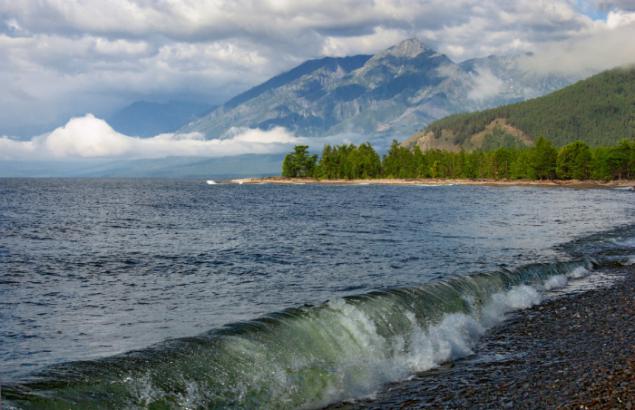
Photos - Alexander Ryutin
Rostov Kremlin
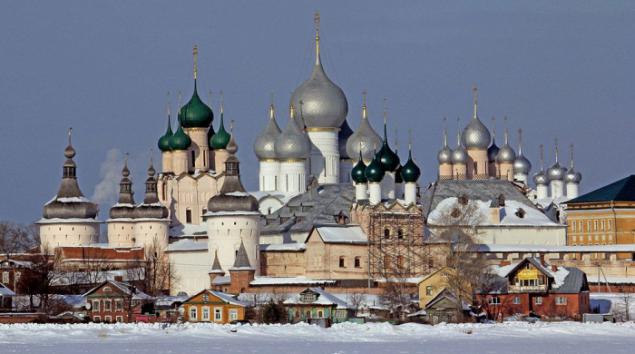
Photo: Valery Abramov
The Kremlin was built in the XVII century as the Rostov Metropolitan, that is, for the residence of Metropolitan Jonah. Therefore, the Kremlin formally call it not for that, the stone walls were rather decorative in nature and should not have been used to defend the city. Total Kremlin has eleven towers. Inside are some of the cathedrals, among which is the Assumption, with its bell tower quadriceps. The Kremlin is also famous for the fact that it was here filming episodes of the film Gaidai "Ivan Vasilyevich Changes Occupation».
PETERHOF

Photography - Ilya Strom
The monument of world architecture and palace and park art. It includes the Palace and Park Ensemble XVIII-XIX centuries - the former suburban royal residence, converted into a museum after the nationalization of 19 May 1918. Peterhof - one of the most luxurious royal summer residence and kind of triumphal monument to the successful completion of Russia's struggle for the Baltic Sea. By the mid 20-s of the XVIII century there were broken regular Upper Garden and Lower Park, built the Grand Palace and some "small" palaces and pavilions, created the world's largest system of fountains and water cascades, made much of the sculptural decoration. The heyday of the park ensemble associated with Nicholas I. When it Peterhof two new landscaped park. Romantic Alexandria Palace Cottage and pavilion with a farm, cottage and Lower Chapel, Kolonistsky park with two islands and pavilions at them Tsaritsyn and Holguin. Today, the reserve also includes a palace and park ensemble of Oranienbaum and the palace of Peter I in Strelna. Museum-Reserve "Peterhof" united 21 museums. Along with the traditional palaces - museums, such as "Catherine the body," "Marley", "Hermitage", you can visit the unexpected, such as Museum "The Imperial bikes" Museum of playing cards "or" Museum of collectors ".
Nizhny Novgorod Kremlin
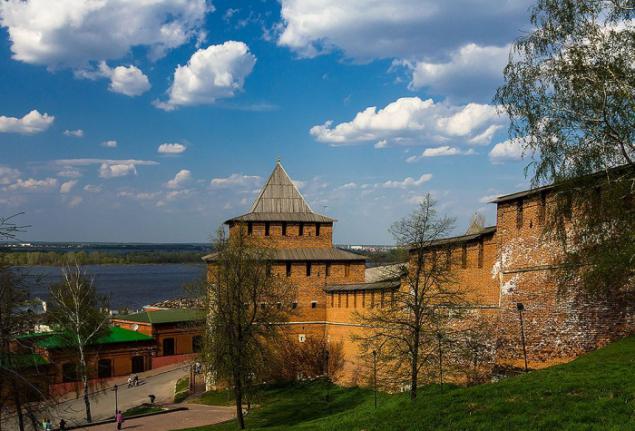
Photos - Alexander Sinderёv
From the annals we know that Nizhny Novgorod was founded in 1221 Grand Prince of Vladimir Yuri Vsevolodovich. Protective fortifications - deep ditches and high ramparts - were originally built of wood and earth. Stone was the Nizhny Novgorod Kremlin in 1515, when there was a need to strengthen the defense of the city - the main stronghold of the Moscow State against the Kazan Khanate. New Kremlin was surrounded by a two-kilometer wall with 13 towers. In the XVI century it was repeatedly besieged by the enemy, but the enemy has never been able to master it.
Mamayev Hill and the sculpture "The Motherland Calls"
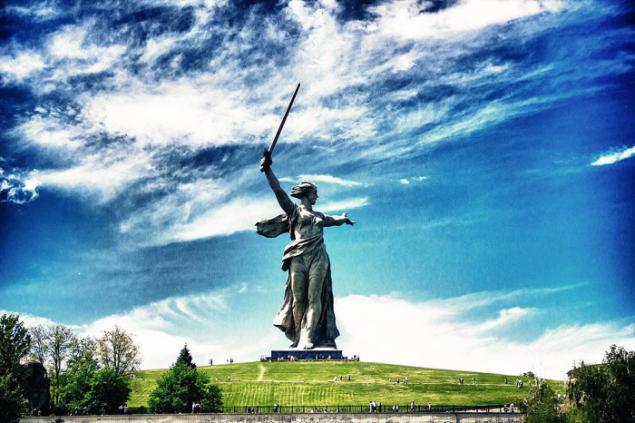
Photos - Anastasia Andreeva
Memorial "Heroes of the Battle of Stalingrad" was opened on the Mamayev Kurgan in Volgograd in 1967. From the square of the Tribulation begins the ascent to the top of the mound to the base of the main monument - "The Motherland Calls & quot ;. Along the serpentine, in the hill reburied 34,505 soldiers - defenders of Stalingrad, and 35 granite gravestones of Heroes of the Soviet Union - participants of the Battle of Stalingrad. The statue by sculptor Vucetic and engineer Nikitin made of 5,500 tons of concrete and 2,400 tons of metal structures. The height of the monument - 86 meters, the height of the sculpture - 53 meters. The thickness of the walls of the sculpture - no more than 30 centimeters. Sword in hand motherland weighs 14 tons and has a length of 33 meters. It is said that in the palm of the statue fits the car. In 2008, a statue of the Motherland on Mamaev Hill is recognized as one of the Seven Wonders of Russia.
Pskov Kremlin (except)

Photos - Valery Abramov
Pskov Krom - the biggest fortress in Europe. The length of the walls - 9 kilometers, the area - 3 hectares. Crom is located on a narrow promontory at the confluence of Pskov in the Great River. Now the Kremlin combines two different time of the city: Detinets to Trinity Cathedral, bell tower, Veche area and Dovmontov city. The pride of Russian art of the XVII century - the seven-tier iconostasis of the Trinity Cathedral. By the most revered shrines of the temple are miracle-working icons, reliquary Pskov saints and Holguin cross. For centuries, the city is constantly threatened with an enemy attack that forced Pskov constantly improve defenses. Pskov Kremlin in its history, withstood 26 sieges. Fortress, the former active military use for nearly 1,000 years, came to us in almost its original form.
Akhmat Kadyrov Mosque "Heart of Chechnya»
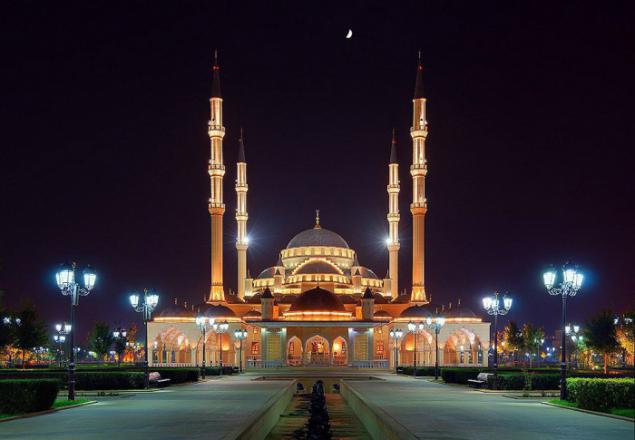
Photos - Timur Agirov
Mosque "Heart of Chechnya" in Grozny - one of the largest, beautiful and majestic mosques in Europe and the world. Opened October 17, 2008 and is named after Akhmad Kadyrov, the first President of the Chechen Republic. The mosque is located on the picturesque banks of the River Sunzha in the middle of a huge park (14 hectares) and is part of the Islamic complex, which, in addition to the mosque, includes the Russian Islamic University. Kunta-Hadji and the Spiritual Administration of Muslims of Chechnya. The mosque was built in the classical Ottoman style. The central hall of the mosque is covered with a huge dome (diameter - 15, 5 m, height - more than 23 m). The height of the four minarets of 63 meters, is the highest minarets in Russia. Exterior and interior walls of the mosque are marble, travertine, and the interior is decorated with white marble. 36 chandeliers installed in the mosque, its shape resembles the three major shrines of Islam: 27 chandeliers mimic Mosque Kubbat-Al Sahra in Jerusalem, 8, modeled mosque Rovzat-Nebevi in Medina, and the biggest, eight-meter chandelier echoes of forms Kaaba shrine in Mecca . The collection of exclusive chandeliers took several tons of bronze, about three kilograms of gold and more than one million pieces and crystals Swarovski. The area of the mosque is 5000 square meters and a capacity of more than 10 thousand people. The same believers can pray in a mosque adjacent to the summer gallery and area. Spread around the mosque a huge park (in a park of more than fifty varieties of trees) with a cascade of colored fountains and night lighting, captivates with its beauty.
Trinity-St
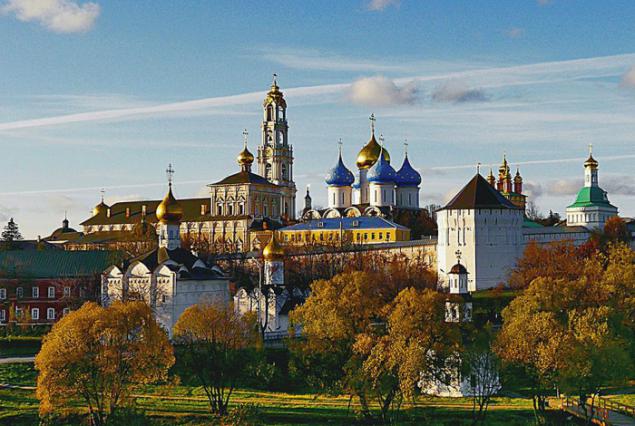
Photos - Vera Ostroumova
Trinity-Sergius Lavra is located in the center of Sergiev Posad, Moscow region, on the river Konchury. Founded in 1337 by St. Sergius of Radonezh. The earliest structure of the monastery is considered to be a white stone Trinity Cathedral, built in 1422 on the site of the wooden church and perpetuate the traditions of Moscow architecture of XIV-XV centuries. This is a unique historical building, one of the few cathedrals where the iconostasis, painted by the greatest master painters - Andrei Rublev and Daniil Cherny. The Trinity Cathedral lie the relics of St. Sergius of Radonezh, who daily come to worship hundreds of parishioners. In 1744, the Holy Trinity Monastery was awarded the honorary title of Lavra. Today it is a functioning monastery, the spiritual center of the Orthodox Russia. Since 1940, Trinity-Sergius Lavra - the State Museum-Reserve. It is protected by UNESCO.
KIZHI
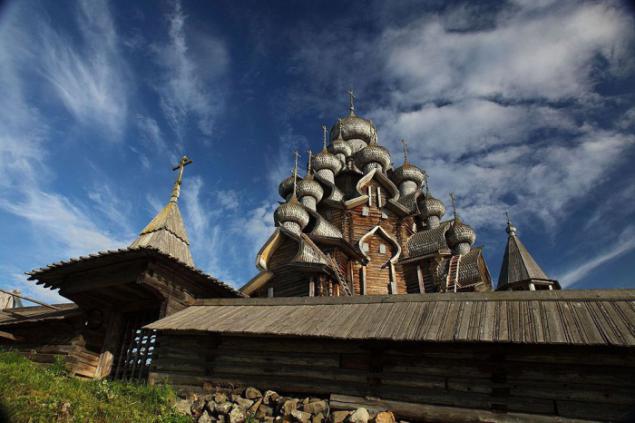
Photo - Oleg Semenenko
This is a unique historical, cultural and natural complex, which is particularly valuable object of cultural heritage of the peoples of Russia and a World Heritage Site. The museum collections - the ensemble of Kizhi. It consists of two churches and bell towers of XVIII-XIX centuries, surrounded by a uniform fencing - reconstruction of traditional fencing graveyards. Church of the Transfiguration, re-erected after a fire in 1714, felled wood (including 22 of the dome and cross), without nails, using an ax and chisel. Long life Kizhi church just because they were built without the use of a saw - woodworking ax does not violate its structure, so the church is not destroyed. In 1966, on the basis of the architectural ensemble of Kizhi was founded the State Historical and Architectural Museum "Kizhi", where, in addition to existing in their original places buildings were SVEZA a large number of chapels, houses and outbuildings from Zaonezhye and other regions of Karelia.
Kolomna Kremlin

Photos - Alex fatigue
Kolomna Kremlin - one of the most powerful fortresses of the Muscovite state, built in the years 1525-1531 during the reign of Vasily III. The Kremlin is located at the confluence of Moscow and Kolomenka. Unfortunately, time has not been kind to the Kremlin - the fortress there were only a few towers and a couple of fragments of the fortress walls. Despite this, the Kremlin and today impresses with its grandeur and power. The most interesting of the seven surviving towers - Marinkina or Kolomenskaya Tower. From this tower connected tradition: here was allegedly imprisoned husband Falsdmitry - Marina Mniszek. Currently located in the territory of the Kremlin Military History Sports and Cultural Complex. It hosts jousting knights and games, contests fighters, fighters and shooters, ancient rituals, folk festivals and fairs.
©
Lake Baikal
Lake Baikal is the largest repository of high-quality fresh water. Lake Baikal is concentrated approximately 1/5 of the world's fresh water reserves and 9/10 Russia. The volume of water in it is greater than all the combined Great Lakes of North America, and 25 times greater than in Lake Ladoga. The length of the lake extends for 636 kilometers in width - at 80. Baikal area is 31,470 square kilometers, which is comparable to the area of Belgium. Lake Baikal - the deepest lake in the world. Its maximum depth is 1642 meters. The average depth of the lake is also great - 744 meters. Flora and fauna endemic Baikal by two-thirds. More than 1,000 species of plants and animals not found in any body of water of the Earth. Baikal seal - the seal - the only representative of mammals in the lake. Baikal - one of the oldest lakes in the world. It has been around for 25 million years, and possibly a nascent ocean. Its shores are drifting apart from each other, just as divergent continents. In 2008, the Baikal is recognized as one of the Seven Wonders of Russia.

Photos - Alexander Ryutin
Rostov Kremlin

Photo: Valery Abramov
The Kremlin was built in the XVII century as the Rostov Metropolitan, that is, for the residence of Metropolitan Jonah. Therefore, the Kremlin formally call it not for that, the stone walls were rather decorative in nature and should not have been used to defend the city. Total Kremlin has eleven towers. Inside are some of the cathedrals, among which is the Assumption, with its bell tower quadriceps. The Kremlin is also famous for the fact that it was here filming episodes of the film Gaidai "Ivan Vasilyevich Changes Occupation».
PETERHOF

Photography - Ilya Strom
The monument of world architecture and palace and park art. It includes the Palace and Park Ensemble XVIII-XIX centuries - the former suburban royal residence, converted into a museum after the nationalization of 19 May 1918. Peterhof - one of the most luxurious royal summer residence and kind of triumphal monument to the successful completion of Russia's struggle for the Baltic Sea. By the mid 20-s of the XVIII century there were broken regular Upper Garden and Lower Park, built the Grand Palace and some "small" palaces and pavilions, created the world's largest system of fountains and water cascades, made much of the sculptural decoration. The heyday of the park ensemble associated with Nicholas I. When it Peterhof two new landscaped park. Romantic Alexandria Palace Cottage and pavilion with a farm, cottage and Lower Chapel, Kolonistsky park with two islands and pavilions at them Tsaritsyn and Holguin. Today, the reserve also includes a palace and park ensemble of Oranienbaum and the palace of Peter I in Strelna. Museum-Reserve "Peterhof" united 21 museums. Along with the traditional palaces - museums, such as "Catherine the body," "Marley", "Hermitage", you can visit the unexpected, such as Museum "The Imperial bikes" Museum of playing cards "or" Museum of collectors ".
Nizhny Novgorod Kremlin

Photos - Alexander Sinderёv
From the annals we know that Nizhny Novgorod was founded in 1221 Grand Prince of Vladimir Yuri Vsevolodovich. Protective fortifications - deep ditches and high ramparts - were originally built of wood and earth. Stone was the Nizhny Novgorod Kremlin in 1515, when there was a need to strengthen the defense of the city - the main stronghold of the Moscow State against the Kazan Khanate. New Kremlin was surrounded by a two-kilometer wall with 13 towers. In the XVI century it was repeatedly besieged by the enemy, but the enemy has never been able to master it.
Mamayev Hill and the sculpture "The Motherland Calls"

Photos - Anastasia Andreeva
Memorial "Heroes of the Battle of Stalingrad" was opened on the Mamayev Kurgan in Volgograd in 1967. From the square of the Tribulation begins the ascent to the top of the mound to the base of the main monument - "The Motherland Calls & quot ;. Along the serpentine, in the hill reburied 34,505 soldiers - defenders of Stalingrad, and 35 granite gravestones of Heroes of the Soviet Union - participants of the Battle of Stalingrad. The statue by sculptor Vucetic and engineer Nikitin made of 5,500 tons of concrete and 2,400 tons of metal structures. The height of the monument - 86 meters, the height of the sculpture - 53 meters. The thickness of the walls of the sculpture - no more than 30 centimeters. Sword in hand motherland weighs 14 tons and has a length of 33 meters. It is said that in the palm of the statue fits the car. In 2008, a statue of the Motherland on Mamaev Hill is recognized as one of the Seven Wonders of Russia.
Pskov Kremlin (except)

Photos - Valery Abramov
Pskov Krom - the biggest fortress in Europe. The length of the walls - 9 kilometers, the area - 3 hectares. Crom is located on a narrow promontory at the confluence of Pskov in the Great River. Now the Kremlin combines two different time of the city: Detinets to Trinity Cathedral, bell tower, Veche area and Dovmontov city. The pride of Russian art of the XVII century - the seven-tier iconostasis of the Trinity Cathedral. By the most revered shrines of the temple are miracle-working icons, reliquary Pskov saints and Holguin cross. For centuries, the city is constantly threatened with an enemy attack that forced Pskov constantly improve defenses. Pskov Kremlin in its history, withstood 26 sieges. Fortress, the former active military use for nearly 1,000 years, came to us in almost its original form.
Akhmat Kadyrov Mosque "Heart of Chechnya»

Photos - Timur Agirov
Mosque "Heart of Chechnya" in Grozny - one of the largest, beautiful and majestic mosques in Europe and the world. Opened October 17, 2008 and is named after Akhmad Kadyrov, the first President of the Chechen Republic. The mosque is located on the picturesque banks of the River Sunzha in the middle of a huge park (14 hectares) and is part of the Islamic complex, which, in addition to the mosque, includes the Russian Islamic University. Kunta-Hadji and the Spiritual Administration of Muslims of Chechnya. The mosque was built in the classical Ottoman style. The central hall of the mosque is covered with a huge dome (diameter - 15, 5 m, height - more than 23 m). The height of the four minarets of 63 meters, is the highest minarets in Russia. Exterior and interior walls of the mosque are marble, travertine, and the interior is decorated with white marble. 36 chandeliers installed in the mosque, its shape resembles the three major shrines of Islam: 27 chandeliers mimic Mosque Kubbat-Al Sahra in Jerusalem, 8, modeled mosque Rovzat-Nebevi in Medina, and the biggest, eight-meter chandelier echoes of forms Kaaba shrine in Mecca . The collection of exclusive chandeliers took several tons of bronze, about three kilograms of gold and more than one million pieces and crystals Swarovski. The area of the mosque is 5000 square meters and a capacity of more than 10 thousand people. The same believers can pray in a mosque adjacent to the summer gallery and area. Spread around the mosque a huge park (in a park of more than fifty varieties of trees) with a cascade of colored fountains and night lighting, captivates with its beauty.
Trinity-St

Photos - Vera Ostroumova
Trinity-Sergius Lavra is located in the center of Sergiev Posad, Moscow region, on the river Konchury. Founded in 1337 by St. Sergius of Radonezh. The earliest structure of the monastery is considered to be a white stone Trinity Cathedral, built in 1422 on the site of the wooden church and perpetuate the traditions of Moscow architecture of XIV-XV centuries. This is a unique historical building, one of the few cathedrals where the iconostasis, painted by the greatest master painters - Andrei Rublev and Daniil Cherny. The Trinity Cathedral lie the relics of St. Sergius of Radonezh, who daily come to worship hundreds of parishioners. In 1744, the Holy Trinity Monastery was awarded the honorary title of Lavra. Today it is a functioning monastery, the spiritual center of the Orthodox Russia. Since 1940, Trinity-Sergius Lavra - the State Museum-Reserve. It is protected by UNESCO.
KIZHI

Photo - Oleg Semenenko
This is a unique historical, cultural and natural complex, which is particularly valuable object of cultural heritage of the peoples of Russia and a World Heritage Site. The museum collections - the ensemble of Kizhi. It consists of two churches and bell towers of XVIII-XIX centuries, surrounded by a uniform fencing - reconstruction of traditional fencing graveyards. Church of the Transfiguration, re-erected after a fire in 1714, felled wood (including 22 of the dome and cross), without nails, using an ax and chisel. Long life Kizhi church just because they were built without the use of a saw - woodworking ax does not violate its structure, so the church is not destroyed. In 1966, on the basis of the architectural ensemble of Kizhi was founded the State Historical and Architectural Museum "Kizhi", where, in addition to existing in their original places buildings were SVEZA a large number of chapels, houses and outbuildings from Zaonezhye and other regions of Karelia.
Kolomna Kremlin

Photos - Alex fatigue
Kolomna Kremlin - one of the most powerful fortresses of the Muscovite state, built in the years 1525-1531 during the reign of Vasily III. The Kremlin is located at the confluence of Moscow and Kolomenka. Unfortunately, time has not been kind to the Kremlin - the fortress there were only a few towers and a couple of fragments of the fortress walls. Despite this, the Kremlin and today impresses with its grandeur and power. The most interesting of the seven surviving towers - Marinkina or Kolomenskaya Tower. From this tower connected tradition: here was allegedly imprisoned husband Falsdmitry - Marina Mniszek. Currently located in the territory of the Kremlin Military History Sports and Cultural Complex. It hosts jousting knights and games, contests fighters, fighters and shooters, ancient rituals, folk festivals and fairs.
©


